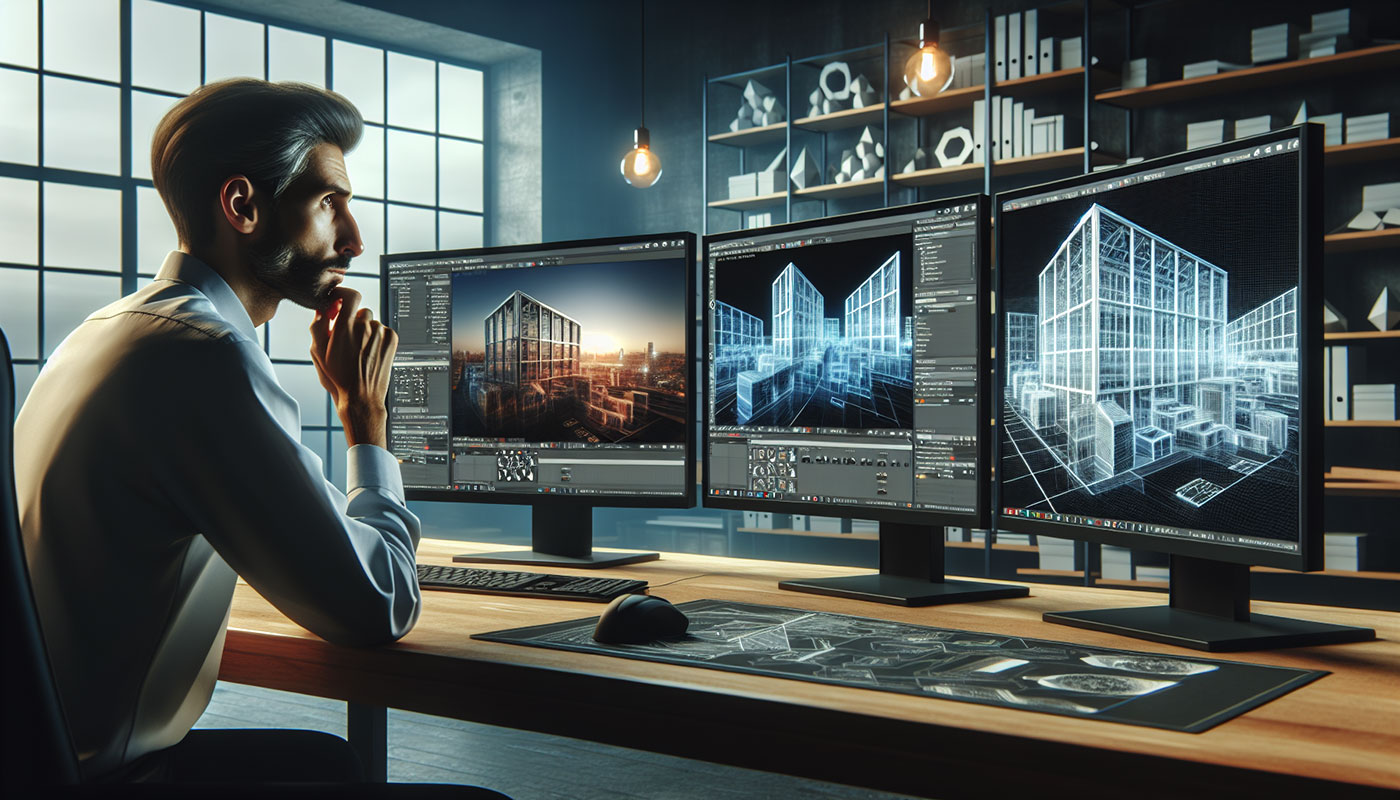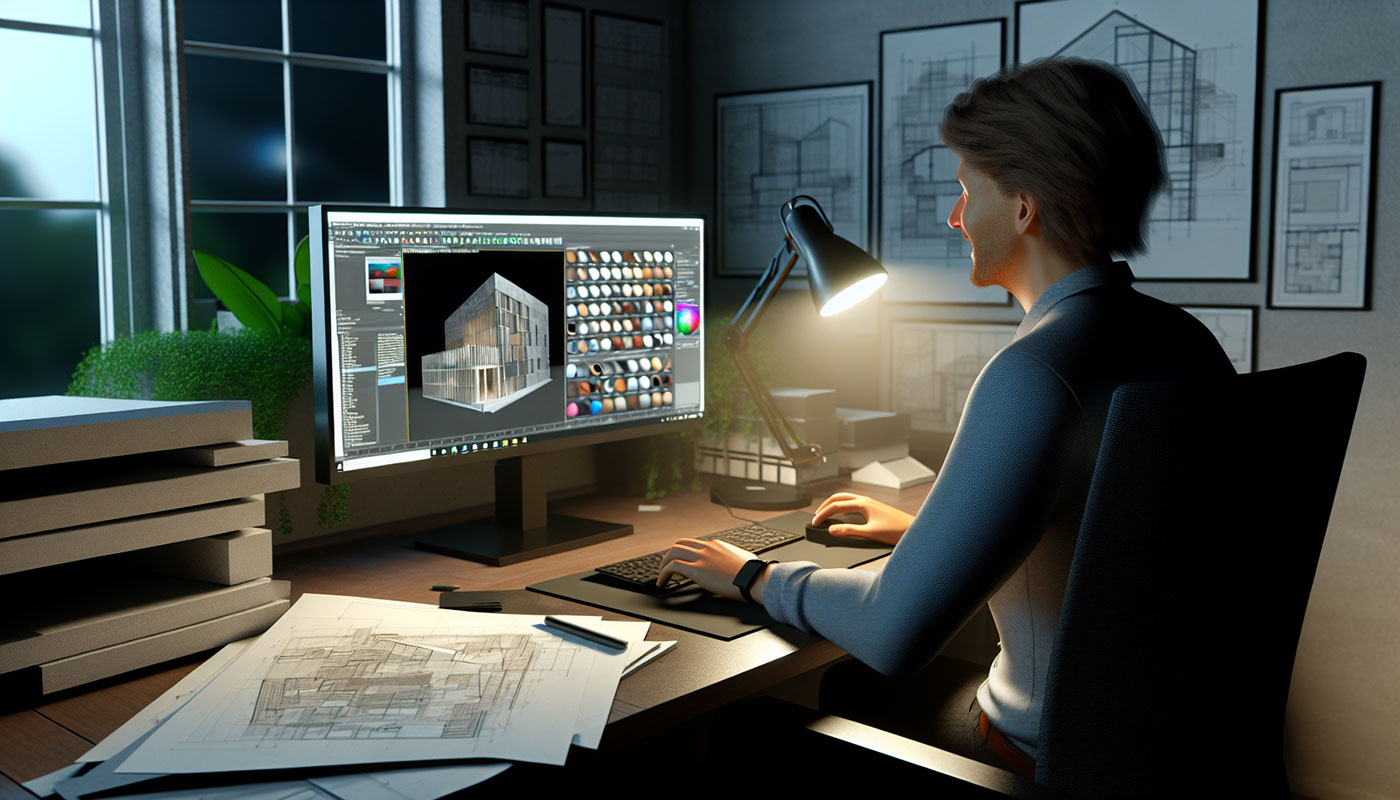Top 3D Rendering Software Solutions for Flawless Architectural Visualization

3D agora
February 7th, 2024

In the competitive field of architecture, the choice of 3D rendering software can profoundly affect the final presentation of your designs. This guide dives into the capabilities, ease of use, and performance of premier 3D rendering tools, providing you with the insights necessary to select the best fit for your architectural needs.
Key Takeaways
Corona Renderer, V-Ray and Lumion are prominent software solutions for architectural visualization, offering features such as real-time rendering, extensive libraries, and compatibility with other design tools, which facilitate high-quality realistic renders.
Factors important in selecting 3D rendering software include ease of use, compatibility with other tools and operating systems, and rendering speed, all of which significantly influence project workflow and efficiency.
While top-tier rendering software such as V-Ray, Lumion, and Corona Renderer offer extensive features and capabilities, cost-effective alternatives like D5, Twinmotion, and Twinmotion provide quality visualization solutions suitable for tighter budgets.
Evaluating the Best 3D Rendering Software in Architecture
 Photo by Lex Photography
Photo by Lex Photography
Several 3D rendering software populate the architectural landscape, each boasting unique features and capabilities. Yet, for superior quality, efficiency, and versatility, V-Ray, Lumion, and Corona Renderer emerge as outstanding solutions. These software solutions have been meticulously crafted to cater to the diverse needs of the architectural community, enabling the creation of breathtakingly realistic renderings.
These platforms are renowned for their smooth integration with widely-used design platforms, efficient rendering capabilities, and extensive material libraries, making them the go-to choices for professionals seeking high-quality architectural illustrations. Let’s delve deeper into each of these powerhouse solutions.
Lumion
Also recognized as a leader in the industry, Lumion is celebrated for its:
User-friendly interface
Real-time rendering capabilities
Intuitive drag-and-drop functionality
Fast results
With these features, architects can produce impressive visualizations without the need for extensive training in specialized software. This ability to quickly and easily explore and present various design ideas makes Lumion a highly favored tool among architects.
In terms of resources, Lumion offers a comprehensive assortment of materials, objects, and models tailored to architectural design, interior design, and landscape architecture within its asset library. This enables architects to enhance their scenes with authentic details, adding to the realism and quality of their renderings.
Corona Renderer
Corona Renderer is a high-performance rendering engine that delivers realistic results with minimal setup and configuration. It is notable for its user-friendly interface and robust workflow tools. Some of its key features include:
Ability to execute both biased and unbiased CPU-based rendering
Procedural tiles for efficient rendering
Scatter controls for realistic distribution of objects
Detailed Edge Map/shader for precise control over edges
Corona Converter - a tool that can convert V-Ray materials into Corona materials.
With these features, Corona Renderer is an essential tool for creating high-quality architectural illustrations.
Corona Renderer offers several features that make it a popular choice among architects for generating lifelike images and animations. These features include:
Interactive rendering, which streamlines material, lighting, and scene setup
Pyro simulations, which allow for realistic fire and smoke effects
Interactive lightmix, which allows for real-time adjustment of lighting in the scene
Chaos Cosmos, which provides a library of ready-to-use 3D models and assets
Chaos Scatter, which simplifies the process of scattering objects in a scene
With these streamlined workflows and powerful features, Corona Renderer is an excellent tool for creating intricate and high-quality visual representations.
V-Ray
V-Ray, a well-known software in three-dimensional modeling, frequently finds favor among architects and visualization artists. Its impressive features include:
CPU, GPU, and Hybrid rendering options
Smart 3D assets
Real-time rendering
Support for hair and fur rendering
These features enable the creation of advanced visual content, including virtual reality experiences. The software’s versatility, characterized by its capacity to generate photorealistic imagery and animations across a wide range of projects, makes it a preferred choice for both interior rendering and exterior rendering.
V-Ray’s compatibility with a diverse array of 3D modeling programs, such as 3ds Max, SketchUp, Rhino, Revit, and Maya, facilitates its seamless integration into the modeling workflows of architects and designers. This, coupled with its precise management of lifelike light and shadow, quick render generation with material libraries, and an intuitive learning process, underscores its reputation as a leading solution in architectural rendering.
Although, it’s worth noting that V-Ray is a less popular option these days. It’s mainly used for bigger masterplans, where a complex interface seems like a more ideal solution. This piece of software gives you more options, however it also uses more RAM and thus, makes it a less appealing choice.
Factors to Consider When Choosing Architectural Rendering Software
 Generated by SurferAI
Generated by SurferAI
The selection of appropriate 3D rendering software is a critical decision with considerable impact on an architect’s work quality. While the software’s capabilities are undoubtedly important, there are other factors that should be taken into account. These include the software’s ease of use, compatibility with other design tools, and rendering speed.
The key factors to consider when choosing architectural visualization software are:
User-friendliness: The software should be easy to use and navigate, allowing architects to quickly create stunning visualizations.
Compatibility: The software should be compatible with other design tools, enabling seamless integration into existing workflows and facilitating collaboration with team members.
Rendering speed: The software should be able to render designs quickly, especially when working with large-scale projects, to ensure efficient project timelines.
Considering these factors will help architects choose the right software for their architectural illustration and visualization needs.
Ease of Use
Any 3D rendering software must possess a user-friendly interface. It can significantly reduce the learning curve, allowing architects to quickly create and modify renderings without spending too much time learning the software. This is crucial in ensuring the efficiency of the project workflow and enabling architects to focus on their design work.
For instance, notable 3D rendering software options for architects such as Autodesk 3ds Max, Twinmotion, and Artlantis, are characterized by their user-friendly interfaces and presets designed for swift rendering. These attributes facilitate an efficient workflow for architects in rendering creation and modification.
Compatibility
When selecting 3D rendering software, compatibility emerges as another vital factor. The software should have the ability to seamlessly integrate with:
Various file formats
Hardware
Operating systems
Other software and plugins
This ensures a smooth workflow and effective collaboration within the project team.
For example, V-Ray supports a range of file formats including:
vrmesh
VRIMG
.vrscene
V-Ray material files
VRayScene
OpenEXR 2 for deep data
This provides flexibility in data exchange with other software.
On the other hand, Lumion integrates into architectural workflows through the import of 3D models from diverse design software, providing great convenience for architects aiming to visualize their designs.
Rendering Speed
Rendering speed is an important determinant of project completion efficiency, particularly when grappling with tight deadlines and large-scale projects. Factors influencing rendering speed include:
Hardware configuration
Chosen resolution
Detail settings
Efficiency of the render engine being used
For instance, Lumion typically outperforms Vray and 3DS Max in terms of rendering speed. To enhance the rendering speed of Corona Renderer, scene optimization techniques such as reducing polygon count and eliminating unnecessary objects, as well as adjusting performance settings in the render setup, can be employed.
Comparing Prices of Top 3D Rendering Software Solutions
 Photo by ThisIsEngineering
Photo by ThisIsEngineering
3D rendering software cost is a major consideration for architects, particularly those operating within a budget. It is therefore essential to compare the prices of top software solutions to make an informed decision. V-Ray, Lumion, and Corona Renderer all offer various pricing and subscription options to cater to different budgets and requirements.
However, it’s important to note that the cost of the software is not the only factor to consider. Other costs such as supplementary expenses, undisclosed charges, and ongoing customer support and updates should also be taken into account, as they can significantly affect the overall cost of the software.
V-Ray Pricing
V-Ray offers a flexible pricing structure, with options for monthly or annual subscriptions. The monthly subscription for V-Ray ranges from $38 to $114.90 USD, and the annual subscription cost ranges from $466.80 to $694.80 USD. However, it’s worth noting that V-Ray no longer provides perpetual licenses and has shifted to a subscription-based pricing model.
Apart from the basic pricing, V-Ray also offers discounts for students and educators, as well as volume licensing options tailored for businesses, making it a versatile solution that caters to a wide range of customers.
Lumion Pricing
Lumion, on the other hand, offers a one-time payment for a perpetual license, priced at $1,499 per year, exclusive of VAT and sales tax. This license includes over 9,100 models and materials, along with fine-detail nature assets.
Despite its one-time payment model, Lumion imposes additional fees for extra licenses at €1499 per seat for Standard and €2999 per seat for Pro, introducing an extra cost beyond the initial license fee.
Corona Renderer Pricing
Corona Renderer provides the flexibility of both subscription and perpetual license options. The monthly subscription for Corona Renderer is priced at €26.90, and the yearly subscription is available for €418.80. For those who prefer a one-time payment, a perpetual license for Corona Renderer is available at €322.80 per year.
Corona Renderer also offers promotional pricing and discounts, such as a 30% discount on the regular price of an annual commercial license for students transitioning to professionals. Moreover, special sales like the Black Friday sale allow customers to save up to 22% off the first year.
Budget-Friendly Alternatives to Popular 3D Rendering Software
 Generated by SurferAI
Generated by SurferAI
While V-Ray, Lumion, and Corona Renderer rank among the top 3D rendering software solutions, they may not present the most cost-effective choices for some architects, particularly those constrained by tight budgets or smaller projects. Fortunately, several budget-friendly alternatives can cater to these needs without compromising on quality and functionality. These include Blender, SketchUp, and Twinmotion.
These affordable alternatives offer a range of features that enable architects to create stunning visualizations. Despite being less expensive than their high-end counterparts, these software solutions do not compromise on quality, making them a great choice for those seeking cost-effective solutions.
Blender
Blender is a free, open-source 3D modeling and rendering software that offers a wide range of features and tools for architectural visualization. It provides support for the complete 3D creation pipeline, including:
Modeling
Rigging
Animation
Simulation
Rendering
Compositing
Video editing
Game creation
This makes Blender a comprehensive and cost-effective option for architects.
Moreover, Blender’s intuitive design and user-friendly interface cater to both novices and proficient users, allowing them to use the software across a wide range of 3D modeling and rendering tasks. This adaptability, coupled with its success in various architectural projects, underscores its reputation as a leading solution in architectural rendering.
SketchUp
SketchUp, on the other hand, is an affordable three dimensional modeling software that offers a user-friendly interface and a vast library of plugins for rendering and visualization. It is employed in architectural rendering for the creation of detailed 3D models and 2D construction documents. Its user-friendly interface and cost-effectiveness compared to other software make it an attractive choice for architects managing budget limitations.
SketchUp’s extensive customization options allow users to:
Modify the viewpoint and style settings of the model within the entity itself
Manage styles and collections
Customize modeling settings
Utilize viewing options to expedite rendering with fast styles
This makes it a versatile tool for architectural modeling and rendering.
Twinmotion
Twinmotion, a real-time rendering software, offers a cost-effective solution for architects. With a price point of $499, Twinmotion positions itself as a considerably more economical option compared to well-established competitors such as Lumion.
Twinmotion offers:
A user-friendly interface
One-click synchronization feature for integration with preferred architectural tools
A library with a wide range of assets such as materials, vegetation, objects, lights, HDRI environments, characters, and vehicles
These features make it a compelling choice for architects seeking a budget-friendly option in their proposed architectural design.
Enhancing Architectural Renderings with Additional Tools and Plugins
 Generated by SurferAI
Generated by SurferAI
Even though the selection of 3D rendering software is critical, final results can be enriched with the use of supplementary tools and plugins to create renderings. These supplementary resources, including material libraries, lighting plugins, and post-processing software, can significantly impact the quality and realism of architectural renderings.
Material libraries can enhance the quality of architectural renderings by integrating high-resolution textures and a wide range of materials. Lighting plugins can create realistic lighting conditions in renderings, enhancing the overall quality and realism of the visualization. Post-processing software allows architects to fine-tune their renderings, adding effects and adjustments to achieve the desired look and feel.
Material Libraries
Material libraries contribute significantly to the enhancement of architectural renderings. They contain pre-made materials like textures, models, and HDRIs that can significantly improve the appearance of 3D objects and achieve photorealistic rendering.
Examples of popular material libraries include:
CGTextures (now known as Textures.com), which offers an extensive collection of high-quality textures
Enscape3D, which provides free downloadable rendering assets for architectural visualizations
TurboSquid, which also offers free downloadable rendering assets for architectural visualizations
Lighting Plugins
Lighting plugins are instrumental in enhancing the overall quality of architectural renderings, aiding in the creation of realistic and accurate lighting visualizations. They allow architects to achieve effects such as:
Directional lighting
Point lighting
Area lighting
Spotlighting
All of these play a significant role in establishing the atmosphere and mood of the rendered scene.
Notable lighting plugins for SketchUp include LightUp, Brighter 3D, and V-Ray, while Lumion offers Omni light, spotlight, and Area light. Additionally, Corona Renderer includes Corona Lights and Corona Light Material, providing a range of options to suit different needs and preferences.
Post-Processing Software
Post-processing software is pivotal in refining and enhancing the final render. It allows architects to apply visual effects and textures and correct any errors in the final image, ensuring a polished and visually appealing result.
Primary post-processing software commonly utilized in architectural rendering includes:
SketchUp
Revit
Archicad
Photoshop
Blender
These tools enable architects to achieve a desired mood and realism in their final architectural renders, including aerial rendering, through the use of realistic visualizations.
Summary
In conclusion, the choice of 3D rendering software can significantly impact the quality of architectural visualization. Whether you opt for industry-leading solutions like V-Ray, Lumion, and Corona Renderer, or cost-effective alternatives such as Blender, SketchUp, and Twinmotion, it’s important to consider factors such as ease of use, compatibility, and rendering speed. Additionally, enhancing your renderings with additional tools and plugins can help you achieve the desired level of realism and detail. Ultimately, the right software will empower you to transform your creative visions into stunning, photorealistic visualizations.